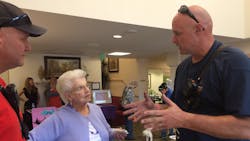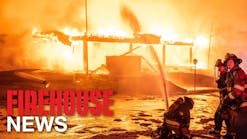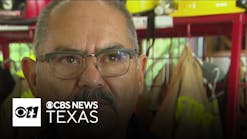Aging Matters: A Multimodule CRR Program
Aging changes our bodies. It changes how we function and how we react to our environment. It changes how we heal. Medicines, alcohol and diet have different effects on our body as we age.
Forty-one percent of patients to whom South Metro Fire Rescue (SMFR) (Centennial, CO) responded in 2019 were elders, or people who are age 65 and older. (Note: I utilize the term “elder” instead of “senior” to acknowledge the individuals’ importance in our society.)
SMFR protects lives and property from all hazards through preparedness, prevention, mitigation and response in 287 square miles in 11 municipalities and in parts of three counties in the southern metropolitan area of Denver. It is an accredited ISO 1 agency. The agency’s more than 700 employees serve more than 540,000 residents. It transports its own patients with ALS medic units.
Six of the agency’s employees—four full-time and two part-time who job-share—are community risk reduction (CRR) specialists. Their mission is to utilize data-driven educational programs to empower audiences to mitigate and prepare for risks.
SMFR’s Operations Division organized the jurisdiction into five battalions to improve span of control, resource deployment and response. Each of SMFR’s five risk reduction full-time-equivalency positions (one of which consists of two part-time employees) is assigned to one battalion and offices at one of the six fire stations that are in each battalion to improve connectivity with firefighters and audiences.
Scalable and flexible
Aging Matters is a multimodule risk-reduction program that targets elders. It predates the five-battalion model but has proved scalable and flexible enough to grow with the district.
In 2019, more than 1,600 elders received risk-reduction programming, which was an expected increase from 2018, because SMFR’s district nearly doubled after merging with Littleton, CO, Fire Rescue. One challenge in 2020 was to increase this output measure again despite obstacles, such as social distancing that was created by COVID-19.
The program is based on a tenet from The Eden Alternative of providing care for people as they age. Each of the modules addresses loneliness, helplessness or boredom, because those three states of mind tend to increase risk, particularly for elders.
The modules target risks that include evacuations, home fires, falls, communication and cardiovascular health.
Evacuations
Evacuations from commercial independent- and assisted-living communities are a significant risk, because most elders who live in those buildings that are in our district don’t react appropriately to fire alarm activations. (Note: We use the term “community” instead of “facility” as a reminder that people live and work there. We are reducing risk primarily for people rather than property.) It isn’t necessarily their fault. State agencies and the Centers for Medicare and Medicaid Services enforces the Life Safety Code. Our agency, through the fire marshal, enforces the International Fire Code (IFC).
Code discrepancies and cultural stigma about what elders can do lead many building administrators and some responders to encourage elders to shelter in place when alarms activate.
If the building is engineered, constructed and staffed to the I-2 standard, occupants can shelter in place or evacuate horizontally. However, if a building is an I-1 or R-2, all occupants must evacuate outside. Thus, our team works extensively with residents, including those who have functional needs, and the staffs of these communities to conduct fire drills as required by the IFC. Our team also encourages residents in independent-living situations to create teams of “Safety Shepherds.”
Safety Shepherds
Basically, Safety Shepherds are floor wardens. They are retired military, teachers and responders and other do-gooders who embrace leadership in their new community. When the fire alarm system activates, they lead neighbors to exits and to assembly areas, where they assist overwhelmed staff with accountability. We give Safety Shepherds reflective vests that have SMFR’s logo to enhance their authority among neighbors during such emergencies and so that firefighters know that they are official liaisons.
Safety Shepherds aren’t responsible for carrying neighbors down stairs or for arguing with neighbors who refuse to evacuate.
This module has proved successful with elders who reside in independent-living communities but not with residents of assisted-living communities, simply because of the physical and cognitive requirements of leadership. However, the first Safety Shepherd used a motorized wheelchair (infection took one of his legs). He volunteered because he recognized himself as a leader among his third-floor neighbors. He worked with an on-site physical therapist to practice lowering himself from his wheelchair and scooting down stairs without assistance.
Smoke alarm blitz
SMFR Battalions 1 and 2 each have a mobile home park that’s restricted to residents who are age 55 and older.
It isn’t a secret that mobile homes burn rapidly, and smoke alarms save lives. Thus, the CRR team implemented smoke alarm blitzes in those two neighborhoods. Staffed with a combination of risk-reduction specialists and SMFR Citizens Academy Alumni, the first blitz was in May 2019 at the Wolhurst Community.
Agency personnel met with 92 residents in 61 of 107 homes. Personnel found that only 41 of the 108 smoke alarms that were in those homes were functional. They installed 88 smoke alarms and four bed-shaker alarms.
The second blitz occurred in February 2020 at Meadowood Village. Partners from the Mile High Chapter of the Red Cross assisted SMFR personnel with the installation of 28 smoke alarms at 15 homes.
My Body, My Wellness
This module teaches audiences how to recognize and react appropriately to heart attacks, strokes, sudden cardiac arrest and choking. Anecdotally, we know that heart attacks are mislabeled as cardiac arrest, that bystander CPR makes a difference, and that each of these conditions can be scary for patients and witnesses.
The presentation explains each acute condition in simple terms, emphasizes why a call to 9-1-1 for EMS transport is preferable to personal vehicles and requests stories from audience members who personally or vicariously experienced such an emergency.
Going forward, this module also will be used to explain symptoms of pandemics (influenza or COVID-19) and appropriate reactions to them, including when to stay home and call the doctor and when to call 9-1-1.
Nose over toes
SMFR firefighters responded to 9,835 patients who were age 65 and older in 2019; 24 percent of those interactions followed a fall. Beyond immediate physical pain, falls often change the patient’s independence permanently.
In the 12 months prior to the writing of this article, the CRR team expanded its commitment to preventing falls and mitigating their effect:
- Partnering with local hospitals to deliver Stepping On programs
- Learning easily taught techniques to improve balance and flexibility from physical therapists, such as the nose-over-toes technique for standing and sitting
- Producing the “Captain Lift Assist” video to address self-lifting after falls (https://youtu.be/g_N0f3LHA18)
- Collaborating with staff at assisted-living communities to Check-Call-Prepare after residents fall to improve SMFR’s capability to respond with appropriate resources
Part of the impetus to address falls and lift-assists was a 2018 change to Colorado’s regulations for assisted-living communities to which SMFR contributed: “Each assisted-living residence shall direct staff to assist residents who have fallen or are otherwise unable to independently get up off the floor.”
Additionally, SMFR’s leadership approved sending three risk-reduction specialists to a train-the-trainer course for the evidence-based Nijmegen Falls Prevention Program that’s taught in The Netherlands.
Communication
The ability to communicate is essential for independence. If you talk and no one listens, you haven’t communicated. If people are ready to listen and you can’t talk, your wishes might not be followed or remembered.
The Paperwork of Aging module explains the importance of having a File of Life or similar documentation of medical history as well as the proper documents that outline desired future medical care. Both types of documents can improve quality of care in prehospital, hospital and rehabilitation settings.
This presentation also covers whether originals or copies are useful, where to post such paperwork (or where to maintain it for others) and who to contact to create such documentation.
Disasters in History
Community partners suggested that elders attend presentations about ecology and history in substantially larger numbers than they attend presentations about safety topics. As a result, our team piloted a new module that’s called Disasters in History.
These 30-minute presentations share a disaster, such as the Triangle Shirtwaist Factory fire, in a lessons-learned format. For example, lessons from this fire reinforce why fire drills, being aware of exits and properly disposing of smoking materials are so important.
The presentations reinforce messages subtly, but the evaluation component shows that audiences are learning intended messages.
Firefighter safety
Aging Matters has another important audience: firefighters.
Much of what we do for risk reduction, generally—and with elders, specifically—directly affects the conditions that firefighters find when they respond to elders’ homes, particularly those who live in commercial facilities.
Seven years ago, our risk-reduction specialists partnered with training officers to conduct tours of commercial assisted-living communities for all firefighters. (During the tour, each crew was out-of-service or on a training delay to maximize their learning potential.)
The tours, which were led by risk-reduction specialists and often included a representative from the fire marshal’s office, emphasized evacuation procedures, such probable areas of congestion, exterior assembly areas, sites for potential triage procedures, exterior and interior access, the fire alarm control panel and demographics about occupants, including the number of staff who work weekends and overnight.
Firefighters also used the tours to update building preplans and to confirm that keys in exterior lock boxes worked.
Challenges
Aging Matters is effective, but it has plenty of room to grow and improve.
Evaluation is a challenge for all of us in CRR. Ideally, we should establish what an audience knows, how they behave and the conditions of where they behave before our intervention so that we can document changes. It also is a challenge proving whether they retain those changes.
Tracking outputs—the number of audience members, of replaced smoke alarms, of brochures distributed, of videos watched—is useful, important and easy. Tracking outcomes, such as whether interventions modify incident data over time, is more difficult, but it’s essential.
Another challenge is reaching elders who live independently in the large jurisdiction. These clandestine elders are responsible for at least as many EMS calls as the number of calls to those who live in commercial communities.
One way that our team modified program delivery is adapting our messaging to existing programs that elders already attend. In the summer of 2019, our team piloted a program at Littleton’s Bemis Library utilizing an audience of elders who attended other programs at the library. Eighty-three elders attended presentations there on home fire safety, fall prevention and other topics.
The challenge of time
A given week only has 40 hours for each of our full-time risk-reduction specialists and 22 hours for each of our job-sharing colleagues. It’s difficult to budget time for presentations to elders during the school year, when we have dozens of classrooms requesting presentations.
Yet, budgeting that time is essential, because this population confronts risk disproportionately.
Aging Matters is a robust toolbox that SMFR uses to prevent, mitigate and respond to those risks. The modules are scalable and flexible—and, thus, replicable for other agencies.
You are welcome to contact us at [email protected] for lesson plans, discussions and ideas.
Einar Jensen
Einar Jensen is a risk-reduction specialist who works for South Metro Fire Rescue in Centennial, CO. He was a firefighter for Clear Creek Fire Authority, Clear Creek County, CO, for 15 years and now has been in the fire service for more than 20 years. He studied environmental history at the University of Montana and the University of Puget Sound and published a cultural history of fire, “Ancient Fire, Modern Fire: Understanding and Living with Our Friend & Foe.” He belongs to the Colorado Risk Reduction Network, the Fire Marshals Association of Colorado and the National Science Teaching Association.






